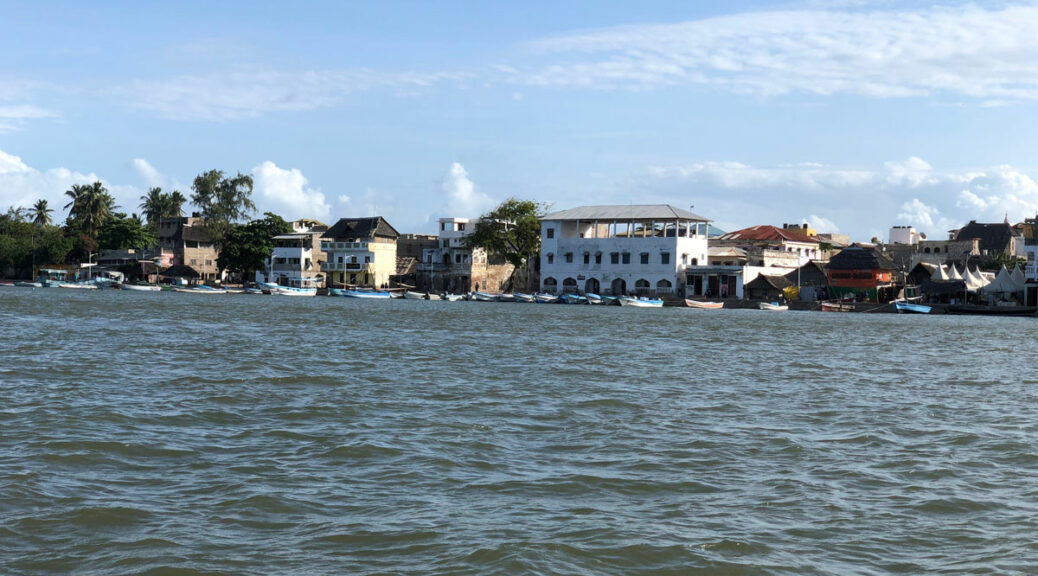“Are you going to Lamu?” asks our friend Dave when we talk about our African expedition. “Where is that?” I wonder. And so begins our research and ultimately, our weekend on Lamu Island, off the coast of Kenya. By Sam Pinnell
Being overlanders, we had hoped to drive up to Mokowe on the Kenyan mainland and take the water taxi across to Lamu Island. But advice from everyone we spoke to was to fly. Lamu is right up near the Somali border and there have been numerous security incidents. Our options would be to drive in a police convoy or take a 25-minute flight from Malindi. An indeterminate, unscheduled holiday in Somalia care of Al-Shabaab seems like an unattractive offer, so we decide to take the early morning plane, leaving our car safely in Watamu.
Lamu is a tiny version of Zanzibar, with an Old Town section as well as beach and resorts. Having been to some really beautiful beaches, we opt to stay in the old town and experience the heritage and culture. Lamu is Kenya’s oldest continually inhabited town, dating back to the 14th century. It is known for its buildings of coral stone and mangrove timber. We are met at the airport by Chengo, the housekeeper at the Airbnb we have booked. From there it’s a 10-minute boat trip across to the island.
There are no cars here; donkeys are used to cart goods and motorbikes carry people while boats cross all day between the old town and the beach area. Chengo takes us on a short exploratory walk so we can get our bearings. He points out markers so we can find our way home in the maze of alleys and corridors. It’s noisy and busy with people going about their daily lives, but everyone is friendly and greets us. We are immediately at ease walking in these narrow spaces threading our way between buildings and people.
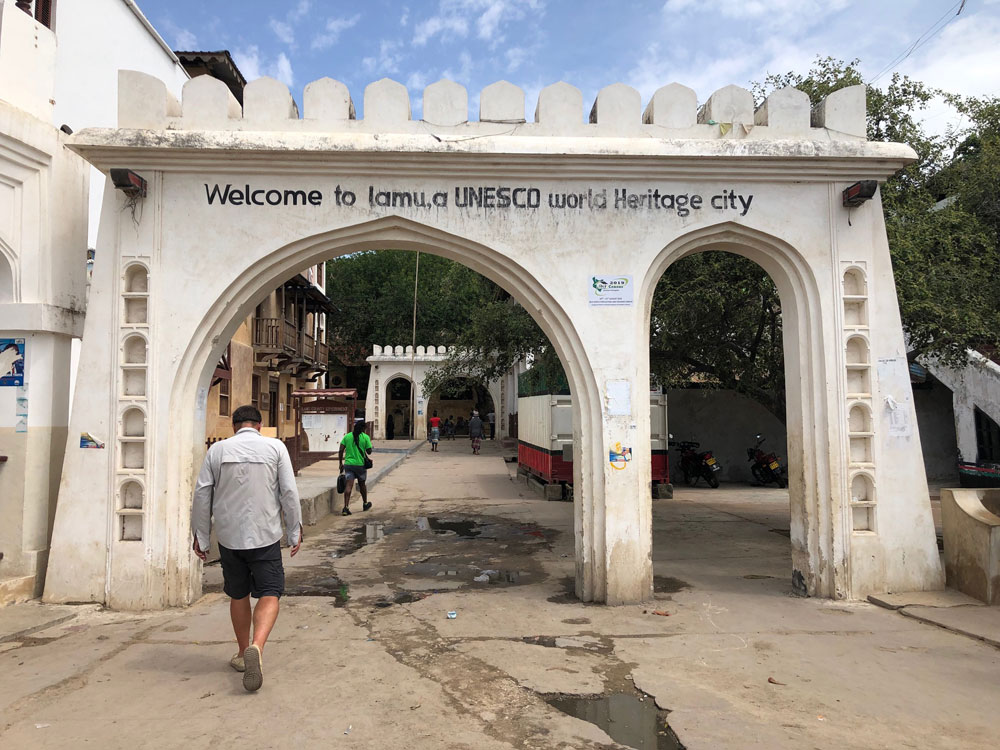
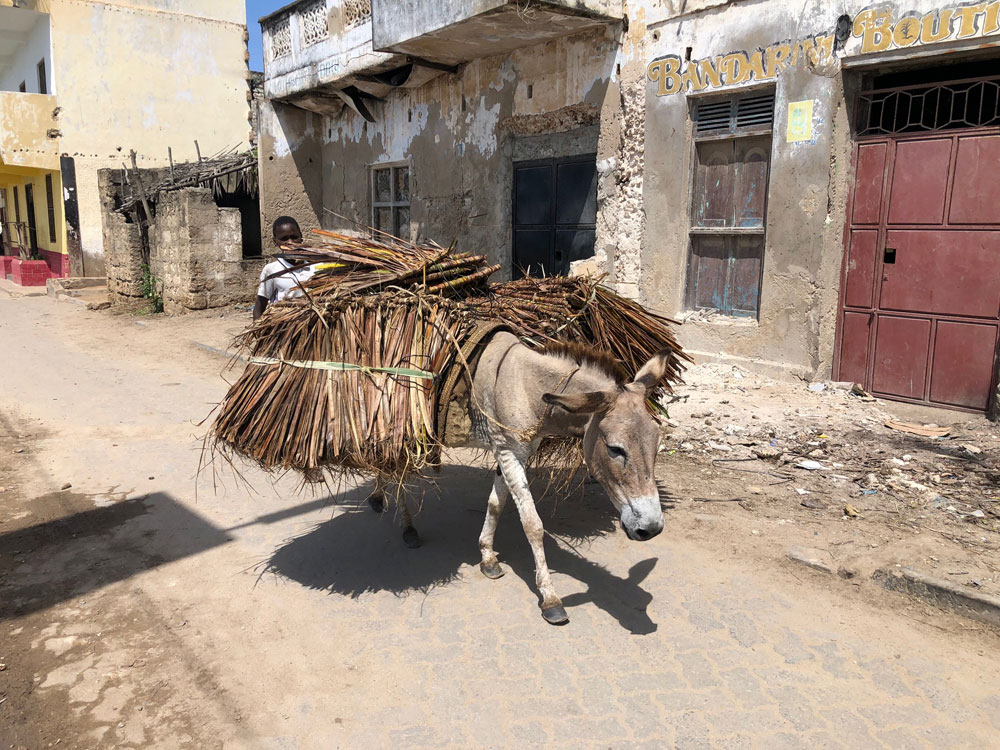
Local flavours
Having been up early to get to the airport, lunch seems like the logical stop. There are a few touristy restaurants and hotels along the harbour waterfront, but we have come for the Lamu experience so we opt for one of the local cafes. Lamu is 95% Muslim, so there is no alcohol available in most of the local restaurants. Instead there is a selection of freshly-squeezed juices and we choose mango and pineapple. I decide on a chapati wrapped around shredded beef and vegetables, while James opts for the spicy chicken pieces. It’s all freshly cooked for us, but we are in no rush as we sit absorbing the sights and smells and hustle and bustle going on around us. There is a young man selling deep fried cassava from his street stall, and he has a never-ending stream of people either sitting down, or waiting for their takeaway. Our food arrives and fingers are the implements of choice. We eat hungrily, the flavours are complex and eastern yet somehow maybe Moroccan. Neither of us leaves a scrap on the plates.
Our own captain
To travel between Lamu town and Shela, the resort area, you can choose between walking, a motorbike taxi or a boat. All along the harbour, the boat captains and motorbike drivers tout for business. The rule here is always negotiate your fee upfront. It’s too hot in the midday heat for the 45-minute walk and we ask a motorbike taxi for his fare. We have a good idea of what we should be paying, so when he asks for more than double, we walk away.
A boat captain has overheard our conversation, and immediately offers to take us in his boat for less. It’s still too high, but he is persistent. When we make an offer, he accepts. Both parties happy, we hop into his boat. We get captain Asman’s phone number so that we can phone him when we need to come back. Having one boat captain that you feel charges fair rates is the best thing you can do. For our entire weekend, we hop on and off his boat as we need him. In the current times of Covid, he is so happy to have some customers and we enjoy his willingness, enthusiasm and local knowledge.
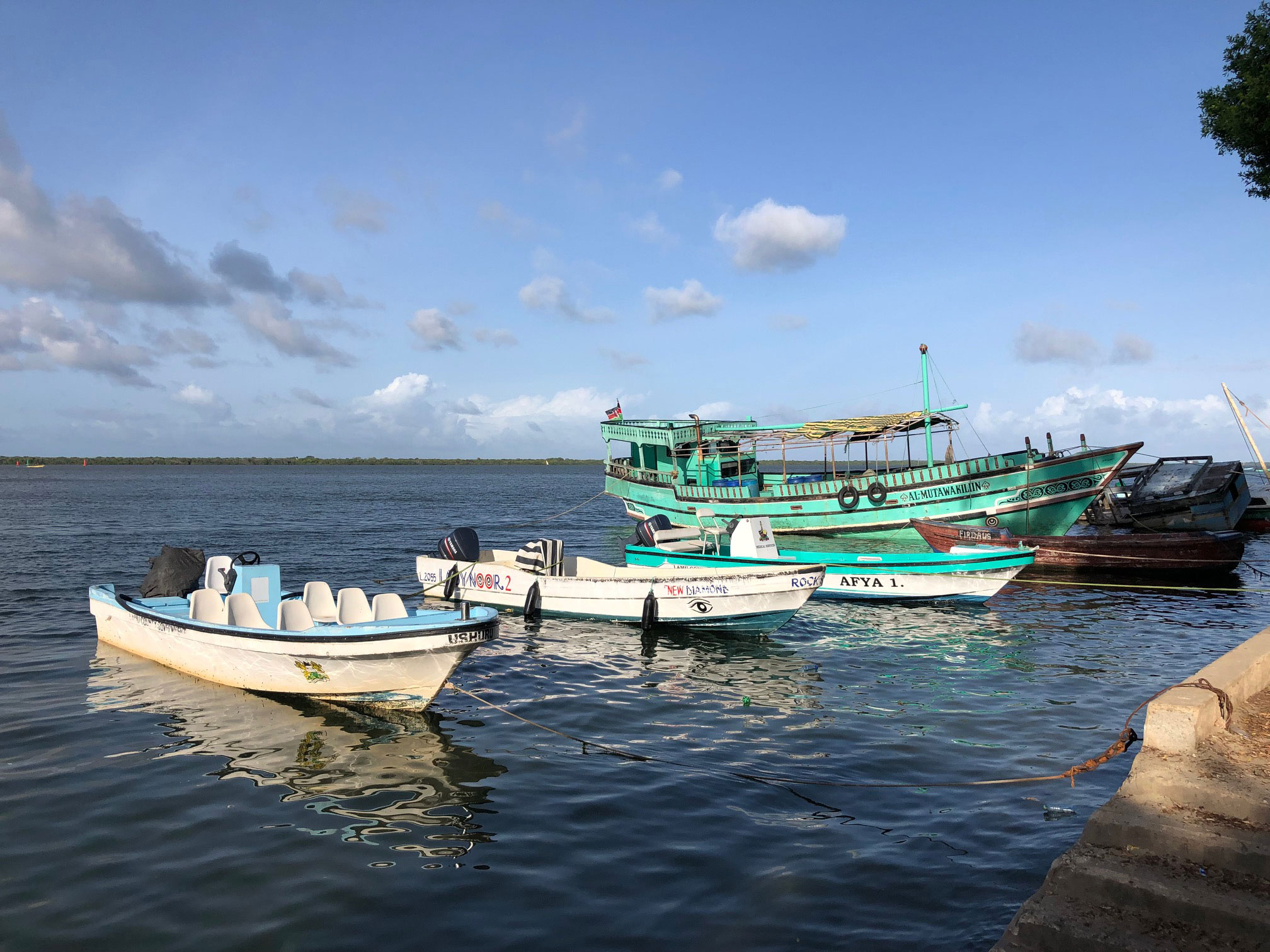
Toasting the sunset
Shela is the main tourist area, and the prices of food and drinks reflect exactly this. We sit on the terrace of the Peponi Hotel with cold beers (the hotels here are allowed to sell alcohol). We watch the boats coming and going, holiday-makers headed to the beach, Maasai traders selling their beads and crafts. The beach reminds us so much of the Wild Coast with sand, waves and dunes. The sea is bath temperature and it’s definitely time for a swim. This is certainly the more glamorous side of the island, but for us, it’s not what we came for, so we call the captain.
He collects us and drops us as at the Floating Bar for sundowners. Owned and run locally, the bar floats in the middle of the water. Boats come and go, dropping and collecting mainly local residents enjoying their Saturday afternoon. The view across the water to the island looks like an overseas magazine, with its white-washed buildings, blue water, green mangrove trees and dhows. The Floating Bar is the perfect place for a cold sundowner beer and one of the few places where you can watch the sunset over the island.
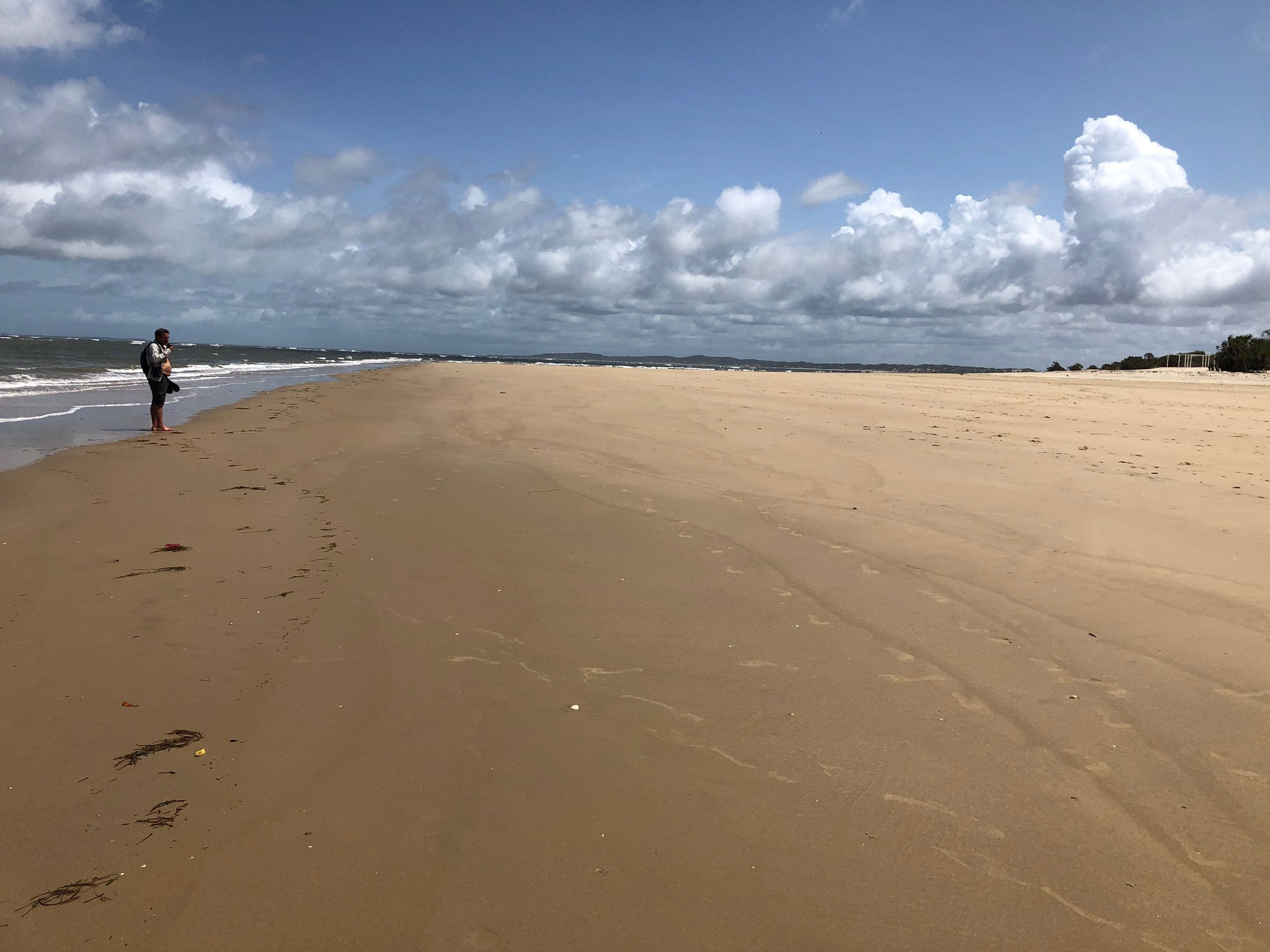
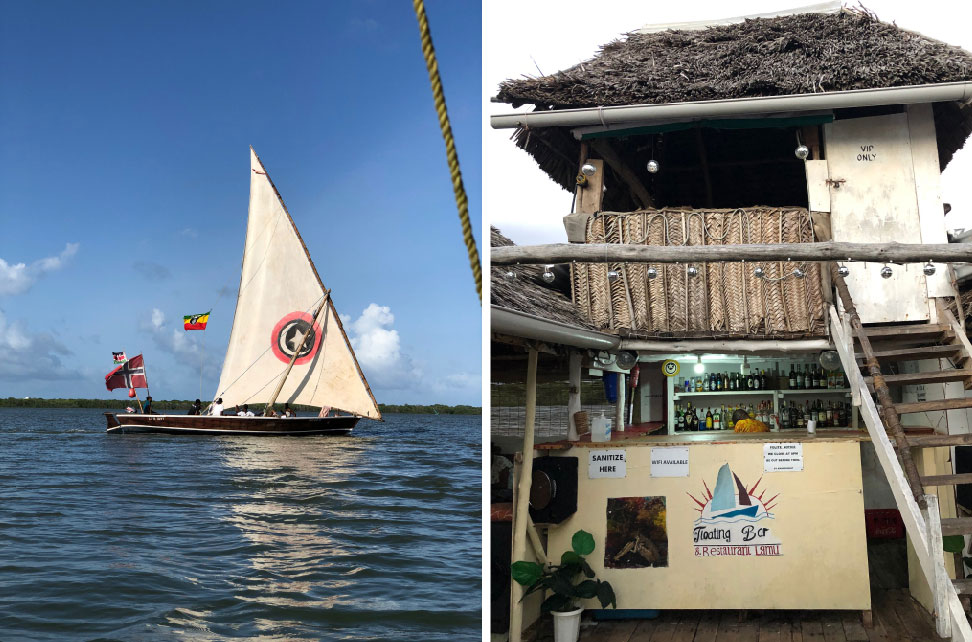
As the sun disappears behind the clouds, our Best Boat captain arrives to collect us and take us back to Lamu in time for dinner at another street cafe. We have a good laugh while we wait for our delicious shawarmas: the heavens open and we watch everyone out in the street running for cover. The rain here is fast and furious but short-lived. While it drenches you, as fast as it starts, it stops again. It’s dark as we make our way home through the alleys, but as always, completely unthreatening and we love it!
‘Mafia’ Island
We spend the next morning exploring town with its alleys and coral architecture, stopping for traditional coffee. We watch donkeys being used to cart rocks, sand, palm leaves and even lengths of steel! They just walk down the roads to the clicks and calls of their owners, they seem to know exactly where they are headed without being led. We call Captain Best and ask him to take us on a tour past Manda Island with its European mansions. Rumour has it that pre-extradition days, a lot of these houses were built by the Italian Mafia, who came here to hide out when the going got tough in Italy. Extradition was then introduced and in one day, authorities descended and swooped up dozens of the mafia members and took them back to Italy and jail. The houses are like something out of a movie set, and are all now owned by various Europeans.
We sail past the mangroves, dhows out doing their sunset cruises, and back to the harbour. We can’t resist stopping for a local “pizza”: it’s a square folded chapati with mince inside, toasted on the fire as we wait. The town is pretty in the soft late afternoon light and we meander around enjoying the world going on around us. We get home to a treat as Chengo has been shopping for us. He presents a mouth-watering homemade dinner of fresh prawns with traditional Swahili coconut ginger rice.
Unforgettable Old Town
On our last day we head for the Museum and the Fort. The museum is housed in the governor’s old house and I am astounded at how big it is. The walls are thick and the interior is cool. Some of the rooms have been left furnished as they would have been, and some turned into galleries. It’s a well maintained museum and worth a visit.
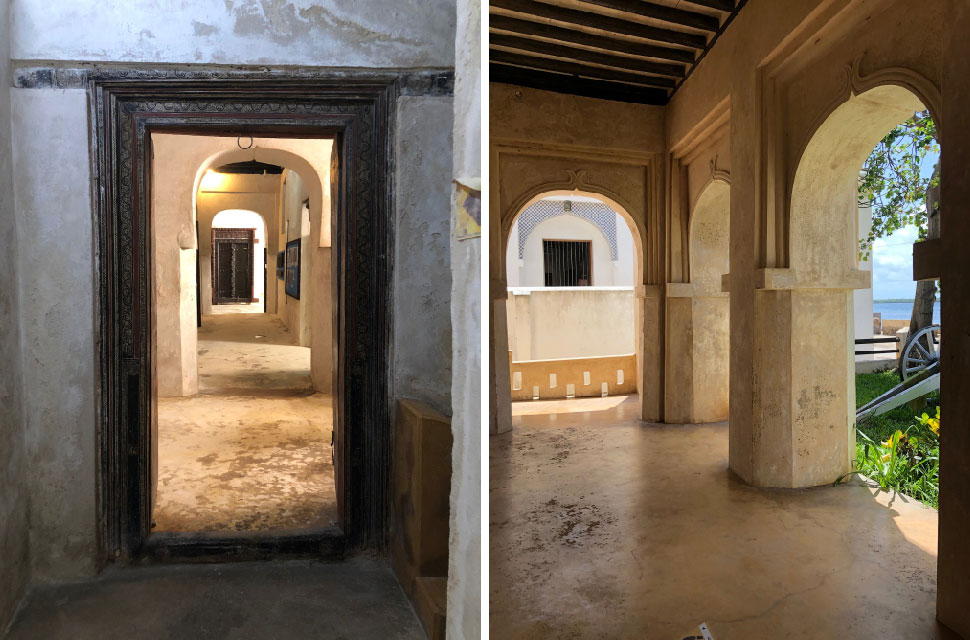
We have a last lunch at the little local cafe we have found, beef pilau, and one last boat ride with Captain Best as we cross back to Manda Airport. We have loved our time here, and our decision to stay in the Old Town and not out in the tourist section of Shela, for us, was the right one. With all its noise and bustle and commotion, we have so enjoyed being a brief part of life in Lamu.
